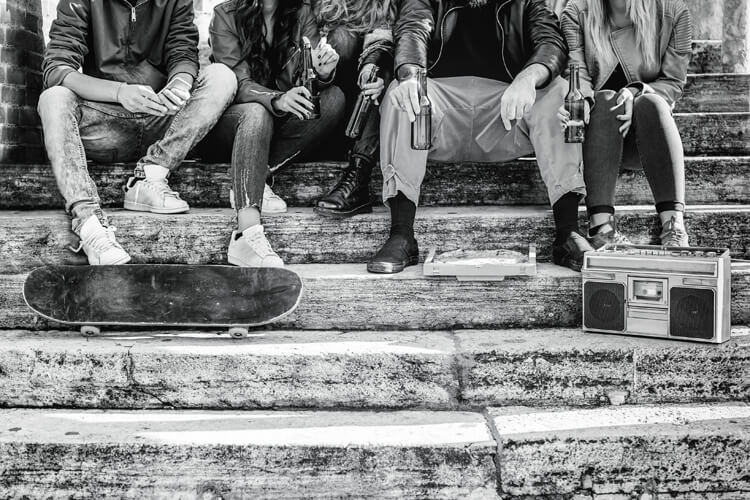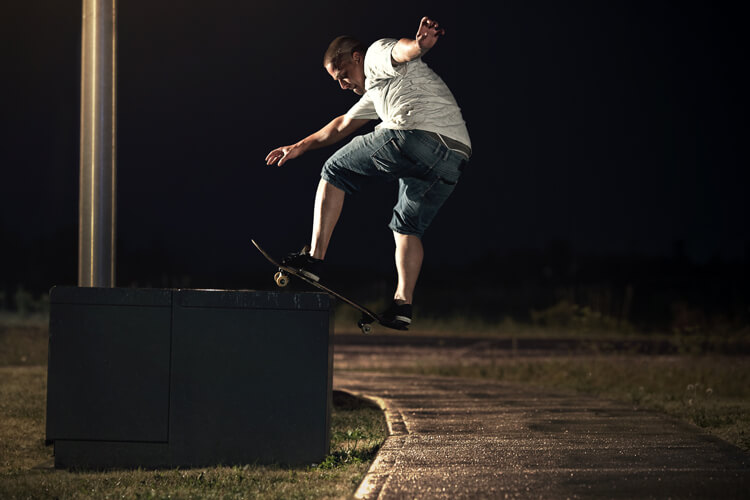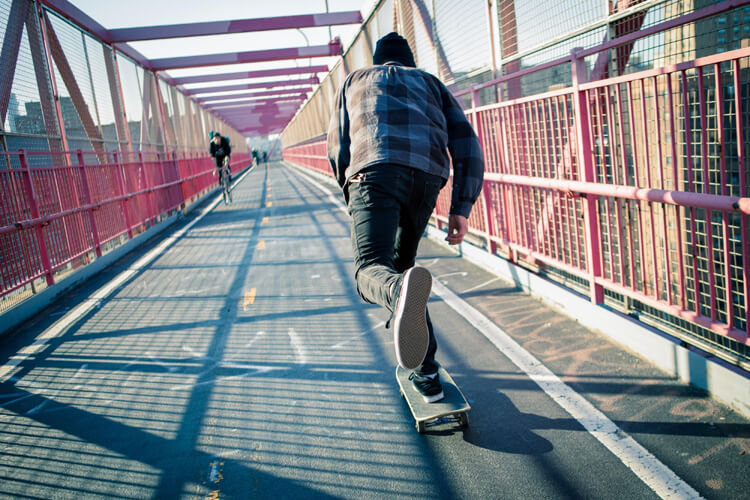Skateboarding is not a crime. The motto has become one of the most famous expressions - and stickers - in skateboard history. Here's what led to its creation.
All skateboarders ever wanted was to have fun and develop their skills and style where they lived.
Skateboarding has always been a city sport that interacts with architecture, buildings, urban objects, landscapes, and spaces.
Skateboarders are not terrorists. Since the sport's early days, it has always been an act of freedom and self-expression.
Surprisingly, skateboarding's first-ever movie - "Skaterdater" (1965) - is an ode to youth, escapism, and freedom.
The majority of skaters act with respect toward their fellow citizens, and confrontational events are extremely rare.
Their only request is the right to access and enjoy public spaces, whether they're riding the asphalt in downtown Los Angeles or hitting the steep streets of San Francisco.
The skater's relationship with pedestrians, business owners, and local authorities has never really resulted in extreme social disruptions or violent demonstrations.
However, you can't be naive to the point of saying there's always been a harmonious and peaceful relationship with all parties involved in the urban context.
The friendly co-existence, here and there, sometimes turned into antagonism and confrontation.

Skateboarders: Public Enemies Number One
In its history, skateboarders have been portrayed as outcasts, rebels, and even criminals. They were the destroyers of private property and the ones who got in the way of old ladies on the sidewalk.
As street skating evolved, the need to explore territories and new limits sometimes collided with the establishment and society as more conservative concepts.
Attempting to develop and land exquisite tricks in maneuvers in high-density urban environments was not compatible with other human activities.
The complaints increased, and as a result, control and repression began to limit the skaters' natural territory and expression.
In the 1980s and 1990s, it was not easy to skate around town.
Skateboarders faced curfews, prohibitive legislation, and bans from public areas, including San Francisco, San Diego, and Santa Cruz, the sport's spiritual home.
The authorities quickly expanded no-skating regulations to New York, Chicago, Denver, Portland, and other large metropolitan areas.
The Washington Post even declared skateboarding a "destructive activity" that should be banned from public spaces like streets, parking lots, driveways, and parks.
No-skateboarding tickets and fines were soon being issued across America and Europe.
Police officers and security guards quickly became skateboarders' worst nightmares.
In the 1990s, skateboarders were regarded and treated as common criminals by authorities and a large percentage of the population.
After the introduction of no-go areas, skateboards were also confiscated, and sidewalk surfers became public enemies.

Anti-Skateboard Laws and Skate Deterrents
Anti-skateboarding legislation continued to spread across the world, including Australia, Brazil, Canada, Mexico, Netherlands, New Zealand, and Sweden.
Arrests have been made, and skaters have become trespassers and troublemakers who should be prosecuted.
With the advent of CCTV surveillance, the protection of property inspired many anti-skateboard laws.
The creation and installation of vertical dividers in benches, rough-textured surfaces, window-ledge spikes, doorway sprinklers, obstructive blocks, restrictive chains, and gravel scattering spread throughout the planet.
Skatestopper, an anti-skate bump created by Chris Loarie, was added to handrails, ledges, and other street furniture to deter skateboarding from multiple sites.
Loarie quickly became skateboarding's worst enemy and one of the most hated people within the skating community.
He was a persona non-grata who was actually profiting from the sport.
By 2015, there were over one million skate deterrents installed at over 10,000 locations.
"Just thank God they don't have guns," former US President George Bush once stated.
Things just couldn't get worse, and skateboarding did indeed decline and lost participants.
Skaters protested, blocked streets, and got media attention - they wanted access to public spaces and more skateparks.
However, the establishment still saw sidewalk surfing as a non-conventional, counter-cultural practice that challenged conformity.
In 2011, skateboarding was still considered a "problem of disorderly youth" by the US Department of Justice.
Self-Expression, Not Crime
There were a few tragedies involving skaters - but they were always the victims.
In 2015, a cab driver killed a chef and longboarder in downtown Toronto; two years later, another driver ran down five skaters in São Paulo, Brazil.
So, while many rapists, murderers, and thieves were free to walk down the streets, anti-skate ordinances grew, and skaters were still portrayed as criminals.
Skaters' untidiness was even referred to as the reason why skateboard bans were implemented in cities.
Interestingly, the expression "Skateboarding Is Not a Crime" is older than the most aggressive and contemporary forms of anti-skating laws.
The powerful motto appeared in Powell-Peralta's 1988 video "Public Domain." The clip featured stickers plastered onto city surfaces and skateboard decks.
The famous slogan was even printed on t-shirts.
Slowly but steadily, "Skateboarding Is Not a Crime" gave birth to a more or less organized international movement that contested skate bans, skate stoppers, and repression.
On May 5, 1997, NHS, Inc., the Santa Cruz skate company founded by Richard Novak, Doug Haut, and Jay Shuirman, registered the one-line pro-skateboarding manifesto trademark.
They knew how powerful, fair, timeless - and commercially engaging, by the way - the phrase was.
But it would take more than a decade to turn the tide around.

A New Era
With the turn of the millennium, things got slowly better, and people and authorities, in general, began to realize that skate just wanted to skate.
The rebellious activity surrounded by an aura of negativity was no longer seen as a public crime in the eyes of the population.
Things were changing in a way similar to what had occurred with its older brother, surfing. Ostracization gave way to recognition.
Surfers are healthy individuals - not beach bums. And skaters are not street criminals - they're talented urban gymnasts.
The drastic growth of the skatepark movement also helped improve and stabilize the relationship between skaters, the police, property owners, and pedestrians.
Go Skateboarding Day, an initiative to promote a healthy outdoor lifestyle via skating, was the tip of a new iceberg emerging in the urban scene.
Today, skateboarding is an incredible complete sport open to people of all ages, races, and social backgrounds.
Boys and girls, men and women, can quickly grab a board and learn to ride it on a smooth surface in less than an hour.
As one of the newest Olympic sports, skateboarding is en route to becoming a universally acclaimed outdoor physical activity.
Its unfair criminal record may forever be an unpleasant memory of the past.
